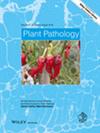大豆和葡萄锈病会加速寄主植物的落叶率
IF 2.4
3区 农林科学
Q1 AGRONOMY
引用次数: 0
摘要
葡萄叶锈病(GLR)和大豆锈病(SBR)分别由热带锈病菌(Neophysopella tropicalis)和大豆锈病菌(Phakopsora pachyrhizi)引起,根据病害的严重程度,可能会导致寄主提前落叶。在旨在模拟产量损失的机理模型中,落叶率是一个重要参数,但对于这些锈病,目前还没有这方面的知识。这项研究的目的是:(i) 将 GLR 和 SBR 的时间动态与落叶联系起来;(ii) 估算相对落叶率,并建立其与锈病严重程度的关系模型。葡萄和大豆植株在田间接种了浓度不断增加的疫霉菌悬浮液。葡萄园和大豆田的对照地块连续喷洒杀真菌剂,以评估自然落叶情况。每隔三四天分别对 1323 片葡萄叶片和 655 片大豆叶片的锈病严重程度(受影响面积比例)进行评估。相对落叶率是根据存活叶片或小叶数量随时间变化的纳皮尔对数线性回归的斜率参数估算的。随着锈病严重程度的增加,葡萄和大豆的落叶率呈对数递增。无症状葡萄树和大豆叶片的落叶率分别为 0.018 天-1 和 0.05 天-1,而葡萄树病叶(锈病严重程度在 5% 到 12% 之间)的平均落叶率为 0.033 天-1,大豆病叶(锈病严重程度在 25% 到 60% 之间)的平均落叶率为 0.12 天-1。因此,葡萄和大豆的锈病严重程度与落叶之间存在定量关系。本文章由计算机程序翻译,如有差异,请以英文原文为准。

Soybean and grapevine rusts accelerate the defoliation rates of host plants
Grapevine leaf rust (GLR) and soybean rust (SBR), caused by Neophysopella tropicalis and Phakopsora pachyrhizi, respectively, may lead to early defoliation of the host, depending on disease severity level. The rate of defoliation is an important parameter in mechanistic models aimed at simulating yield loss, but such knowledge is not available for these rust diseases. This work aimed to (i) relate the temporal dynamics of GLR and SBR to defoliation; and (ii) estimate the relative rates of defoliation and model their relationship with rust severities. Grapevine and soybean plants were inoculated in the field at increasing concentrations of urediniospore suspensions of the respective causal agent. Control plots of the vineyard and the soybean field were protected with sequential fungicide sprays to evaluate natural defoliation. Rust severity (proportion of area affected) of each leaf or leaflet was evaluated every three or four days on 1323 grapevine leaves and 655 soybean leaflets, respectively. The relative rates of defoliation were estimated as the slope parameters of linear regression of the Napierian logarithm of the number of alive leaves or leaflets over time. Defoliation rates in grapevine and soybean incremented logarithmically with the increase of rust severity. Defoliation rates on symptomless grapevine and soybean leaves were 0.018 and 0.05 day−1, respectively, while they averaged 0.033 day−1 on diseased grapevine leaves (rust severity between 5% and 12%), and 0.12 day−1 on diseased soybean leaflets (rust severity between 25% and 60%). Thus, a quantitative relationship was established between rust severity and defoliation on grapevine and soybean.
求助全文
通过发布文献求助,成功后即可免费获取论文全文。
去求助
来源期刊

Plant Pathology
生物-农艺学
CiteScore
5.60
自引率
7.40%
发文量
147
审稿时长
3 months
期刊介绍:
This international journal, owned and edited by the British Society for Plant Pathology, covers all aspects of plant pathology and reaches subscribers in 80 countries. Top quality original research papers and critical reviews from around the world cover: diseases of temperate and tropical plants caused by fungi, bacteria, viruses, phytoplasmas and nematodes; physiological, biochemical, molecular, ecological, genetic and economic aspects of plant pathology; disease epidemiology and modelling; disease appraisal and crop loss assessment; and plant disease control and disease-related crop management.
 求助内容:
求助内容: 应助结果提醒方式:
应助结果提醒方式:


